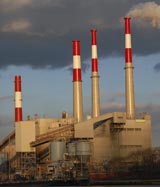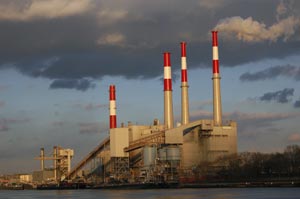
Treating FGD Purge Streams
Solution for air rule compliance brings on wastewater issues
- By Chris Edmonds
- Nov 07, 2008
 Many electric generating utilities that burn coal are engaged in retrofit projects using flue gas desulfurization (FGD) to meet emissions standards mandated by Phase 2 of the Clean Air Act. A large number will be completed by 2011; however per industry reports, retrofits will continue to be made as late as 2020. A significant number of these projects involve wet limestone-forced oxidation scrubbers.
Many electric generating utilities that burn coal are engaged in retrofit projects using flue gas desulfurization (FGD) to meet emissions standards mandated by Phase 2 of the Clean Air Act. A large number will be completed by 2011; however per industry reports, retrofits will continue to be made as late as 2020. A significant number of these projects involve wet limestone-forced oxidation scrubbers.
In developing wet limestone FGD retrofit programs, utilities should develop a strategy for the associated wastewater treatment system to treat the scrubber chloride purge stream. To maintain the required operating conditions in the scrubber, a purge stream is discharged from the system primarily for chloride control (for compatibility with the scrubber's materials of construction and to achieve sulfur dioxide removal efficiency) and to a lesser degree for fines control. The purge stream contains pollutants from coal, limestone, and make-up water. It is acidic, supersaturated with gypsum, and contains high total dissolved solids (TDS) and total suspended solids (TSS), composed of gypsum, heavy metals, chlorides, magnesium, and dissolved organic compounds.
Some plants located on large flowing rivers can directly discharge their wastewater after the FGD purge goes to the ash pond for suspended solids settling, pH adjustment, and dilution of the heavy metal concentrations. This mixing action can satisfy requirements for National Pollutant Discharge Elimination System permits. More commonly, however, facilities must treat or contain the purge before discharging it to the receiving water body. A number of options may be considered (see Options box), but the most common is physical-chemical treatment, which is the primary subject of this article.
Characterization of wastewater
FGD wastewater composition can vary from plant to plant. The flow rate and characterization are affected by boiler size, scrubber equilibrium chloride concentrations, fly ash removal efficiency, gypsum dewatering system type and efficiency, FGD process, and coal, limestone and make-up water composition. Systems have varied in size from 20 gallons/minute (gpm) to 1,200 gpm.
The discharge limits also can vary significantly, depending on state regulations, the availability of an existing high flow rate discharge stream (for example, once-through cooling water), the nature of the receiving waterbody, and the year the FGD system goes into service, since discharge requirements are getting stricter. Table 1 depicts purge characteristics and discharge limits for three power plants.
The scrubber purge stream is treated in a dedicated wastewater facility, rather than an existing treatment system, for the following reasons:
• The existing wastewater system has inadequate capacity for the purge.
• The materials of construction of existing treatment equipment are unsuitable for treating high chloride wastewater.
• High TDS and supersaturated conditions would result in scaling the existing system.
• The existing system's process design is inadequate for the strict wastewater discharge limits.
• The additional sludge generated may exceed the capacity of the existing system.
The specific FGD wastewater treatment system must be designed to meet current wastewater composition and discharge requirements but also have some flexibility for meeting future requirements either as designed and constructed or with minor modifications or add-ons to the system.
Options for Treating FGD Purge Wastewater
• Physical-chemical treatment to reduce total suspended solids, adjust pH, de-supersaturate the purge stream, and reduce heavy metals. Since 2004, about 14 systems have been installed and are operating in the United States; 27 more are under construction.
• Biological treatment to reduce selected heavy metals (such as selenium), and/or organics resulting from use of organic acids, and/or to reduce total nitrogen (usually due to ammonia slip from a selective catalytic reactor). This system is usually preceded by a physical-chemical system to protect it from scaling and suspended solids overload. Since 2004, about eight biological treatment systems have been installed or are planned for installation at FGD wastewater facilities.
• Zero liquid discharge (ZLD) using thermal units (evaporator, crystallizer, spray dryer). Only one was operated briefly in the United States in the 1990s, but it experienced scaling, plugging, corrosion, and high capital and operations and maintenance costs. Two more have been ordered in recent years, with one under construction and one canceled during construction.
• ZLD using deep-well injection. One is in operation in the United States, and one is under construction. This option costs $5 million to $6 million per well, with two to three wells per site. This system also requires a physical-chemical treatment system preceding it to reduce suspended solids and to de-supersaturate the wastewater to prevent scaling in the high temperature, high pressure deep-well environment.
• Sludge stabilization by mixing FGD purge with fly ash for land filling. None are currently being built; however, about 15 were constructed in the 1970s-1980s. This approach eliminates the ability to sell fly ash for commercial products and requires extra landfill volume.
• Stacking the gypsum for either final disposal or future reclaim. This will absorb some of the purge in the stack. Liquid runoff is collected in holding basins, mixed with ash water, or held in solar evaporation ponds (in favorable climates). A couple of these designs are under construction but could be required to retrofit to treat the gypsum stack runoff.
• Constructed wetlands treatment system. Only three have been completed, and performance has been mixed. |
Treating the stream
A basic building block in the wastewater treatment system has been an integrated physical-chemical treatment system. Variations of this system have been used, but the predominant one being installed is the two-stage reaction tank design, as shown in Figure 1. This design is cost effective and provides the required performance for proper desaturation and heavy metal removal.
The wastewater originates from the gypsum dewatering system's two-stage hydroclone unit and will contain about 0.5–2 percent suspended solids. An equalization tank attenuates purge flow and chemistry.
Pumps move the wastewater to reaction tank No. 1, where alkali is added (usually hydrated lime) for pH adjustment to approximately 8.5–9.2 and gypsum de-supersaturation of the wastewater. Proper pH control is essential to optimize the effectiveness of the other chemicals added to precipitate heavy metals and to avoid magnesium precipitation, which would increase the solids, impact the efficiency of the dewatering unit, and increase scaling potential.
Recycle of seed sludge from the clarifier to reaction tank No. 1 provides sites for gypsum crystal growth to aid in de-supersaturation, which also prevents scale on the downstream equipment. The alkali also precipitates abundant metals, such as aluminum, iron, and manganese as metal hydroxides.
Metal sulfides have much lower solubility than metal hydroxides. Thus, in order to meet the low effluent requirements for heavy metals, organosulfide is dosed into the reaction tank to further precipitate the heavy metals.
For flocculation, an iron salt such as ferric chloride is added to reaction tank No. 2. The iron salt helps denser flocs form, enhancing clarifier performance. Some other metals, non-metals, and organic matter also will co-precipitate.
After the flocculation step, polymer is added in an in-line mixing zone prior to the clarifier to aid in coagulation and solids settling in the clarifier. The wastewater is clarified in a solids contact clarifier. Hydrochloric acid is used to lower the effluent pH to neutral, which prevents scaling in downstream equipment. Gravity filtration polishes the treated effluent to enhance TSS and metals reduction prior to discharge.
Backwash reject from the gravity filter returns to the equalization tank for reprocessing. The treated effluent usually flows to the plant's ash pond or is mixed with cooling system effluent prior to discharge to the final receiving water body.
Pumps send the clarifier sludge, usually in the range of 10–15 weight percent solids, to an agitated sludge holding tank prior to being dewatered in filter presses on a batch basis. The sludge tank volume is sized consistent with the utility's plans for filter press operation during the week, weekends, and holidays.
The most common filter press being used for FGD wastewater sludge is the recessed chamber press. However, for very large sludge production (greater than 200,000 lb/day dry solids), belt filter presses may be used. The dewatered solids or "filter cake" is discharged from recessed filter presses at 40–50 weight percent solids to roll-off boxes or to truck trailers and are disposed of in non-hazardous lined landfills, either onsite or offsite. Belt presses will typically not achieve this level of dryness. The dewatered solids generally must pass the U.S. Environmental Protection Agency's "Paint Filter Liquids Test" and the leachate should meet federal regulations regarding toxicity, in order to be considered non-hazardous.
Depending on the discharge permit for the power plant, additional treatment may be required downstream. A biological system can be used to reduce nitrogen, organics, or selenium. The physical-chemical system is still needed for pH adjustment, de-supersaturation, suspended solids reduction, and removal of much of the heavy metals. If these tasks were not accomplished, the biological systems would not operate properly.
Table 1: FGD Wastewater Characteristics and Discharge Requirements for Three Representative Plants |
Parameter
|
Plant 1
|
|
Plant 2
|
|
Plant 3
|
|
Specified Purge |
Discharge Limits |
Specified Purge |
Discharge Limits |
Specified Purge |
Discharge Limits |
pH (S.U.) |
5.0 - 6.0 |
6.5 - 9.0 |
5.5 - 6.5 |
6.5 - 8.0 |
5.5 - 6.5 |
6.0 - 9.0 |
Temp (F) |
125 |
NA |
125 |
NA |
130 |
NA |
|
|
|
|
|
|
|
Constituents |
ppm |
ppm |
ppm |
ppm |
ppm |
ppm |
TSS |
= 18,000 |
<10 |
<15,000 |
<30 |
20,000 |
<!5 |
TDS* |
40,000 |
40,000 |
30,000 |
NA |
NA |
NA |
Chloride* |
12,000 to
15,000 |
12,000 to
15,000 |
15,000 |
NA |
15,000 |
NA |
Total Nitrogen |
NA |
NA |
81 |
10 |
NA |
NA |
Aluminum |
10 |
1.5 |
12 |
2 |
14 |
2 |
Arsenic |
1.5 |
0.1 |
3 |
NA |
3 |
0.1 |
Cadmium |
0.45 |
0.1 |
0.5 |
0.03 |
0.5 |
0.1 |
Chromium, total |
0.3 (Cr3+ form) |
0.1 |
0.5 (Cr3+ form) |
0.1 |
1 |
0.1 |
Copper |
0.85 |
0.1 |
0.2 |
0.1 |
0.8 |
0.1 |
Iron |
20 (dissolved) |
0.5 |
20 |
1 |
|
|
Lead |
0.5 |
0.1 |
4 |
0.1 |
4 |
0.1 |
Mercury |
0.5 |
0.002 |
0.8 |
0.001 |
0.8 |
0.001 |
Nickel |
2 |
1.0 |
5 (90% particulate) |
0.3 |
6 |
1 |
Selenium |
4.6 |
3 |
5 |
NA |
5 |
2.835 |
Silver |
0.3 |
0.02 |
0.3 |
0.05 |
0.03 |
0.05 |
Zinc |
5 |
0.1 |
5 |
0.1 |
8 |
0.1 |
*Parameters not significantly impacted by physical chemical treatment |
About the Author
Chris Edmonds is director of Sales for Siemens Water Technologies Corp., in Warrendale, Pa. He can be reached at (905) 693-0339 ext. 3978.